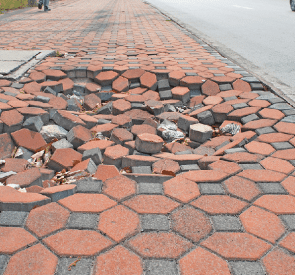Can I make a claim for a slip, trip or fall on the pavement?
Slip, trip and falling over while out and about are one of the most common types of personal injury claims we handle. Fortunately, most of these accidents only result in minor injuries. However, some can result in more serious injuries and have serious consequences including broken bones, concussion, deep lacerations and permanent scarring.
A local council will usually have a duty to inspect and maintain footpaths and roads falling within their local authority. Many claimants mistakenly believe that any fall that leads to an injury would be enough to form a successful claim. The reality however is very different, and to succeed there are two ‘hurdles’ that must be met.
The ‘first hurdle’ – the defect itself
There are several possible causes of a pavement trip fall such as:
- Raised paving slabs;
- Potholes;
- Exposed tree roots;
- Damaged or cracked paving slabs; and
- Uneven stones;
The defect itself has to measure more than 25mm or 1 inch above the normal pavement level. The council will not be held liable in circumstances where the defect is less than the specified amount.
Photographic Evidence

To show the defect is above 25mm you should take some photographs. Place a tape measure, ruler or coin next to the area where you tripped and send the photographs to your solicitor. The pictures should be clear and up close.
The photographs should be taken as soon as possible following the accident. If it is not possible to take the photograph yourself, please ask a friend or family member to do so. A photograph taken a couple of months after may not be helpful to your case as the defect can change significantly over time.
You should take some pictures of the surrounding area as well. It is important to show the local shops or houses within the photograph. This will assist the council with their investigations and also allow your solicitor to contact witnesses to determine how long the defect was present prior to the accident.
The ‘second hurdle’ – inspection records.
The council will not be found at fault if they can prove they carried out regular inspections. Depending on how busy the area is the inspections could take place monthly (for high streets) or annually (for residential areas).
The council usually provide us with a copy of their inspection records for that particular area over the last 12 months. If the records show they did not have an adequate inspection in place then we would be able to bring a successful claim against them.
However, the council will not be held liable if they can show that they had an adequate system of inspection and during their last inspection the defect was either (1) not present or (2) did not pose a risk to pedestrians at the time.
Unfortunately, these sorts of cases are notoriously difficult to win. It is therefore crucial that you are able to provide your solicitor with cotemporaneous evidence at the beginning of your claim. Without sufficient photographic evidence, a case may not even pass the first hurdle.


